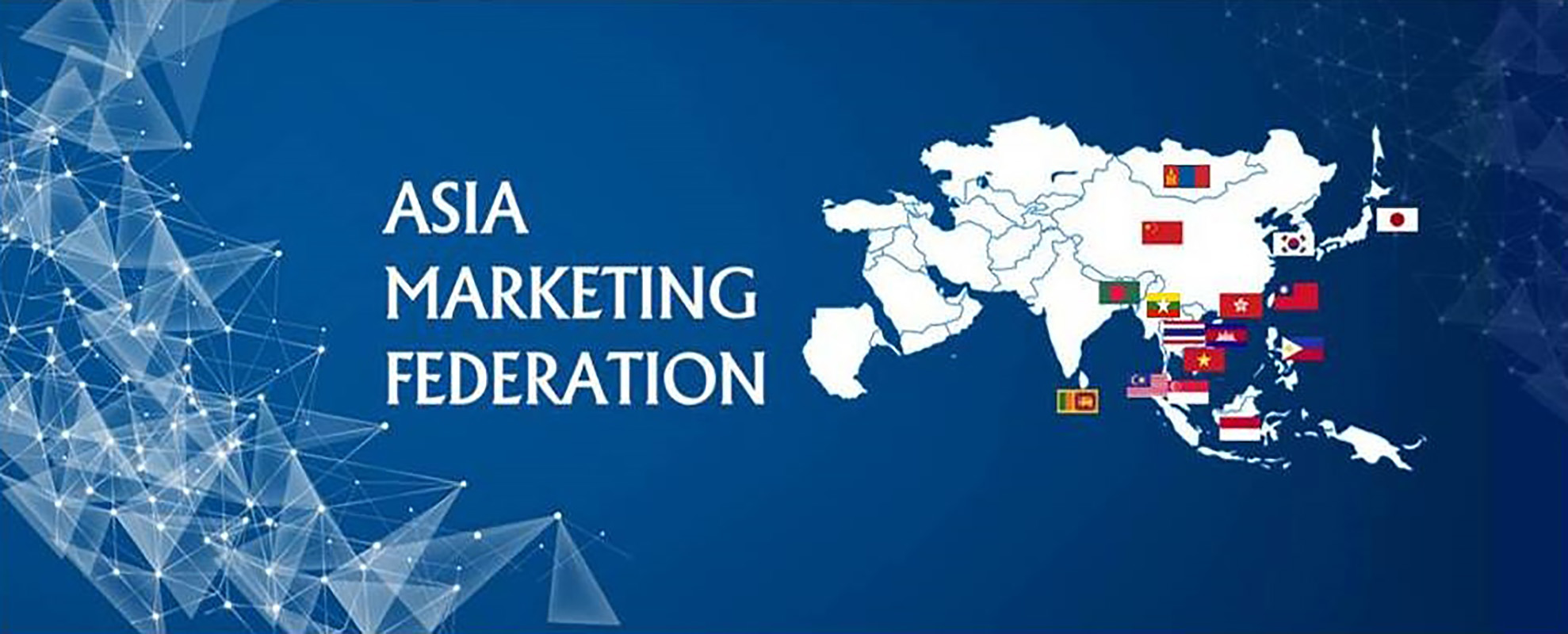9 Top Trends of Marketing in Asia 2019
Asia Marketing Federation (AMF) and Marketing Association of Thailand (MAT) issue a special report on the 9 Top Trends of Marketing in Asia 2019. The report is the synthesis of the professional foresight and consolidated wisdom of the Asian marketing fraternity.

Top 9 Trends of Marketing in Asia 2019
- Banking retail streamlining and digital payment platform – Fintech
We are seeing more adaptation of digital technology especially within the banking sector in the area of customer service, payment and credit worthiness rating. There is a need to embrace analytics driven marketing. In particular, we are seeing innovative ways of assessing customer worthiness through their spending patterns rather than their existing financial health and commitments. At the retail scene, there is a proliferation of multiple cashless payment via connected accounts, cards and e-wallets. In the area of e-wallets, we foresee the streamlining of the e-wallets payment options.
- OMNI channel – increased popularity and accelerated adoption by retailers
The move of e-commerce giants to acquire brick-and-mortar retailers has highlighted the importance of OMNI marketing, the seamless integration of online and online marketing. This, in turn, has influenced smaller e-commerce players and brick-and-mortar retailers to incorporate OMNI marketing in their business strategy.
More retailers are starting to evolve their OMNI channel strategy where customers can enjoy digital enhanced shopping experience, interact and purchase with the merchant online/offline seamlessly. From going to shop to experience “touch and feel” of the products, online query on color/size/stocks availability right up to the purchase and delivery arrangement all done online while still at the shop.
- Rise in utilization of Digital Payment and disruption of traditional currency business with digital currency
With the improvement to the digital experience of e-commerce players and the facilitation of mobile transactions, Digital Payment Platforms are starting to take on a new role. Several institutions have explored the possibility of treating Digital Payment Platform as a distribution channel for ultra-micro loan. This type of loan will be attractive to borrowers if the cost of fund is more economical. On the other hand, by analyzing data about the behavioral pattern of Digital Payment Platform users, it can help the lender to minimize the risks associated with ultra-micro loan.

Photo: DNA India
We are seeing more adaptation of digital currency in daily transaction. This has affected traditional businesses such as money changer and traditional small retailers that offer only cash payments. There’s more cross-regional currency exchange digitally whereby the exchange rate can be influenced not by regional monetary authority but by market forces. It will also have an impact of the exchange rate in terms of real time volatility.
- The increased usage of Artificial Intelligence and its transition towards Hybrid Intelligence (HyIntelligence)
In the corporate world, the role of Artificial Intelligence (AI) has started to help companies to personalize their engagement with the customers. By using AI tools, companies with very large number of customers can collect and compile data of their customers and use it to improve customer experience and build strong relationship (Experiential marketing).
Currently AI and HI are mostly limited to interaction as in Industrial 4.0. Artificial Intelligence learning is based on big data that are input by human intelligence to anticipate and execute tasks to be performed as in the case of Chatbot and SIRI. Hybrid Intelligent (HyIntelligent) is the next level of intelligence where we see integration of AI and HI at neuro level. This will greatly enhance human capability and effectiveness. An example would be embedding AI nanochip in human that are able to pick up neuro pulses thereby cutting down verbal and physical interaction. The AI tools will continue to help companies to execute personalized engagement not only to a large number of customers but also in higher frequency. However, human and ethical issues should be taken into consideration with the extensive application of all the above mention technologies.
- Increased popularity of Intrapreneur
Many professionals from companies across the region are taking the plunge to start up their own companies. However, the percentage of successful start-up companies is very small and most of them failed to scale-up. This resulted in both the professionals, and the companies they work for losing the opportunity to create value. To avoid such a situation, many companies are starting to encourage their professionals to become intrapreneur. The professionals are encouraged to take bigger risks, in return, they are offered various benefits of intrapreneurship from shared ownership in the newly created company, houses and other non-monetary incentives for a win-win partnership.
- Drone technology as a marketing tool and advertising medium
We are seeing more drones being used as a marketing tool. In the past, to capture stunning aerial shots, we need to deploy expensive cranes, scaffolds/fixtures and even helicopters. Nowadays, video marketing is within an arm’s reach of consumers in Asia. Hence, even real estate agents are creating video content in YouTube to offer breathtaking aerial shots of the properties they are marketing. Small independent film makers are using Drone Technology to offer creative angles in their movie making. Many bloggers are now incorporating drones into their short video. Drones are being used as a mobile advertising medium carrying messages in traditional print medium and in some cases projecting digital messages on prominent landmark.

Photo: Diana Măceşanu at Unsplash
- Impact of Retail disruption by unmanned 24/7 Vending Machines
More and more vending machines with cash and non-cash options are doting the Singapore landscape. They offer from simple freshly squeezed orange juice, convenience goods to vending of vacuum packed fresh salmon. Some of the advantages of Vending Machines are - they operate unmanned 24/7 and offer multiple payment options beyond cash. As such they are disrupting traditional retailers like fruit juice vendors, corner convenience stalls and to some extend even big chain stores. At the same time, these Vending Machines double up as a big outdoor advertising medium, circumventing the expensive Out-Of-Home (OOH) advertising cost thus disrupting part of advertising agencies business. As such marketers will have to understand target market segment, the strategic locations and their use as an OOH and harness the Vending Machines as a potential traditional or digital communication tool.

Photo: Yahoo News Singapore
- The growing popularity of business with social impact
The always-connected customers who are constantly updated 24/7 with the happenings around them tend to make decisions influenced by emotional judgment. On the other hand, the growing commoditization by businesses have hindered their abilities to engage emotionally with customers. To differentiate themselves from competitors, more businesses are adopting social responsibilities as one of the many ways to engage their customers. These ranges from fund raising for social programs, lending support towards a social cause to embracing causes such as environmental responsibility and sustainability. These social initiatives, in turn, enable them to tell stories about their businesses through the various social media platform. It helps create relevance and emotional attachment for these companies to market their brand. However, marketing without consumer empathy is out, and with the rise in fake news, authenticity in these marketing communication is crucial in building high trustworthiness factor in consumer.
- Understanding and leveraging on Smart Home Technology
Grocery shopping at traditional outlets may be disrupted by enhanced Smart Home technology where devices (eg. home appliances like refrigerator) with AI technology will monitor consumption behavior. It will then automatically send request to home owner to remind them to place order for low inventory items. With integrated network link directly to suppliers, digital payment and delivery infrastructural in place, the landscape of grocery shopping is expected to change. With Smart Home getting more and more prevalent, AI in Smart Home with face recognition and AI technology will monitor individual behavior and provide personalization in lifestyle home living - ie. from home temperature setting to ambience lighting to entertainment like personalized music and television programs. Hence, marketer will need to understand emerging Smart Home technology and learn how to harness this technology to market their products. Marketers will need to leverage the power of personalization. Hence, personalization and customer intimacy is becoming the new standard in Marketing.

Asia Marketing Federation is the networking body of marketing associations in Asia. AMF has a critical mission as the premier regional body which effectively promotes the interests of marketing in Asia and strengthens the Asian marketing fraternity. Its member countries include Bangladesh, Cambodia, China, Hong Kong, Indonesia, Japan, Korea, Macau, Malaysia, Mongolia, Myanmar, Philippines, Singapore, Sri Lanka, Taiwan, Thailand and Vietnam.
ลงทะเบียนเข้าสู่ระบบ เพื่ออ่านบทความฟรีไม่จำกัด






